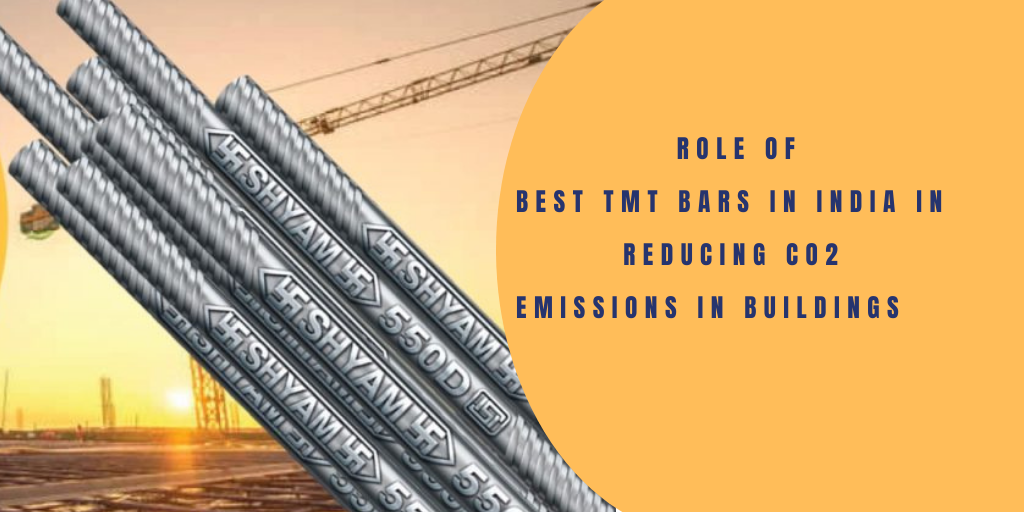Role of Best TMT Bars in India in reducing CO2 emissions in buildings
In recent years, there has been a growing concern about the environmental impact of construction activities. One of the significant contributors to greenhouse gas emissions is the production of cement, which is a primary material used in building construction. However, the use of TMT bars in building construction can help to reduce CO2 emissions significantly. In this blog, we will discuss the role of TMT bars in reducing CO2 emissions in building construction and why using the best TMT bars in India is essential.
TMT bars, also known as Thermo-Mechanically Treated bars, are a type of reinforcement steel used in construction. These bars are made by passing steel wires through a rolling mill at high temperatures, followed by quenching and tempering. TMT bars are known for their high strength, ductility, and toughness, making them a popular choice for building construction.
One of the key advantages of using TMT bars in building construction is their ability to reduce the amount of steel required for a project. This is because TMT bars have a higher strength-to-weight ratio than traditional reinforcement steel. This means that less steel is required to achieve the same level of strength, which can significantly reduce the carbon footprint of a building project.
Another way that TMT bars can help to reduce CO2 emissions is by reducing the amount of cement required in construction. TMT bars are often used in conjunction with concrete to provide additional strength and durability. However, because TMT bars have a higher strength-to-weight ratio, they can reduce the amount of concrete required in a project. This means that less cement is needed, which can significantly reduce the carbon footprint of a building project.
It’s important to note that not all TMT bars are created equal. When selecting TMT bars for a building project, it’s essential to choose the best TMT bars in India to ensure that the highest quality materials are being used. The quality of TMT bars can vary based on factors such as the manufacturing process, the grade of steel used, and the level of quality control.
Further, when selecting TMT bars for a building project, it’s essential to consider the specific requirements of the project. For example, if the building is located in a seismic zone, it’s essential to choose TMT bars that can withstand seismic forces. Similarly, if the building is located in a coastal area, it’s important to choose TMT bars that can withstand corrosion.
In Kolkata, there are several options for TMT bars. However, when it comes to choosing the best TMT bar in Kolkata, it’s essential to consider the quality and reliability of the manufacturer.
One such manufacturer is Shyam Steel Industries Limited, famous as one of the best primary steel producers in the nation. The organization produces two of the best TMT bars in India. They are Fe 500D & Fe 550D TMT Bars. These TMT bars are made using high-quality steel and undergo a rigorously tested manufacturing process to ensure that it meets the highest standards of quality. Both Fe 500D & Fe 550D TMT Bars are known for their high strength, ductility, and toughness, making them an ideal choice for building construction.
Let’s walk you through how these two TMT Bars help in bringing down CO2 emissions.
The use of Fe 500D and Fe 550D TMT bars in building construction helps to reduce CO2 emissions in several ways, they are:
- Reduced Steel Consumption: Fe 500D and Fe 550D TMT bars have higher strength and ductility than conventional bars, which means that less steel is required to achieve the same level of strength. This reduces the overall steel consumption in building construction, which in turn reduces the CO2 emissions associated with the production of steel.
- Reduce Transportation Emissions: Fe 500D and Fe 550D TMT bars have higher strength and ductility than conventional bars, which means that they can be manufactured with a smaller diameter. This reduces the weight of the bars, which in turn reduces the transportation emissions associated with their delivery to the construction site.
- Longer Life Span: Fe 500D and Fe 550D TMT bars have a longer life span than conventional bars, which means that they do not need to be replaced as frequently. This reduces the CO2 emissions associated with the production, transportation, and installation of replacement bars.
- Energy-Efficient Buildings: Fe 500D and Fe 550D TMT bars are used in the construction of high-rise buildings and structures, which require less energy for heating and cooling due to their superior thermal properties. This reduces the overall energy consumption of the building, which in turn reduces the CO2 emissions associated with the production and use of energy.
The above processes highlight how the use of TMT Bars ensures a huge reduction of CO2 emissions in buildings, delivering a cleaner and greener environment – providing opportunities for sustainable expansion in the construction industry.

